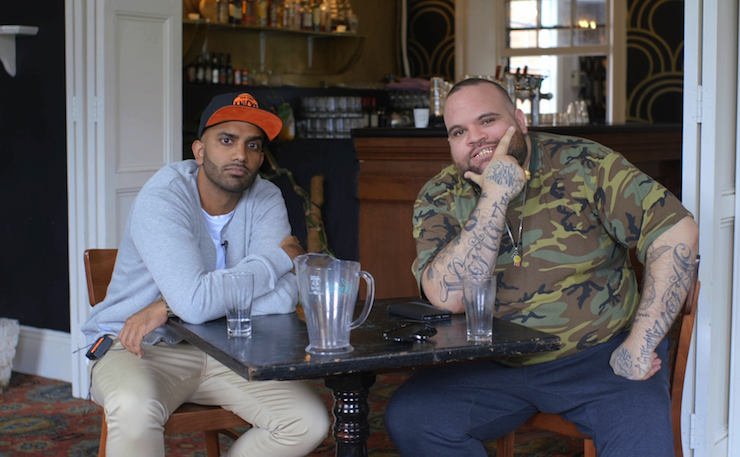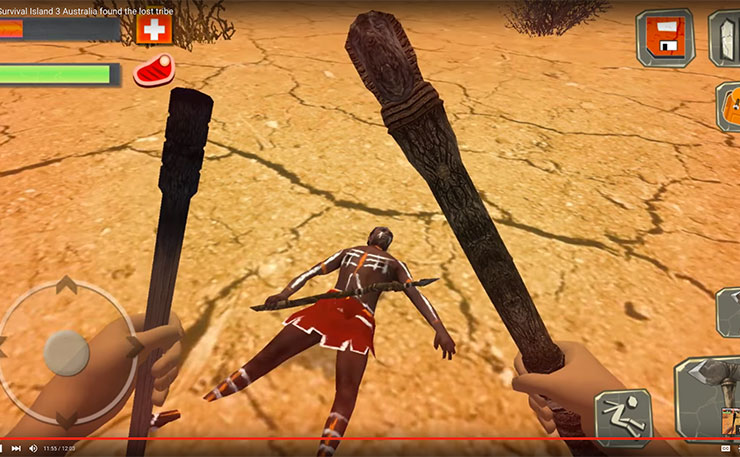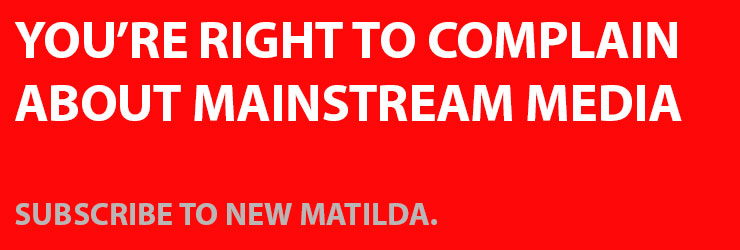ANALYSIS: If you want to know why Australian society seems so racist, look upwards, suggests Liam McLoughlin.
2016 is a ripper of a year for Australian racism. Apple allows the release of Survival Island 3, an app in which you can bludgeon to death an ‘Aborigine’, and gives it a PG rating for children 12 and up.
Wagga Wagga Citizen of the Year Joe Williams is subjected to nationwide abuse and told to return his award by councillor Paul Funnell for refusing to stand for the national anthem. Meanwhile his moving speech about the personal toll of racism is largely ignored.
Yorta Yorta rapper Briggs and comedian Aamer Rahman face a torrent of racist abuse following a VICE video discussing Australia Day.
Two Ballarat men dress up in blackface and Gunditjmara woman Sis Austin is harassed and bullied online for complaining about it.
Opal forward Alice Kunek wears blackface as Kanye West while swimmer Stephanie Rice stands in solidarity with Kunek. Teammate Liz Cambage denounces her actions and then cops a wave of Internet abuse.
And it’s only February.

One common response to all this is “Can you believe this is happening in 2016!? I mean come on, it’s like, 2016!”
It may be, like, 2016, but it’s also, like, 20 years since John Howard was elected. For at least 20 years now (and probably more like 228 years), there’s been a catastrophic bipartisan consensus in Australian politics that black lives don’t matter.
The relentless government attacks on Aboriginal people through policymaking and rhetoric can’t help but impact the behaviours and attitudes of Australian citizens. It’s in this context of institutional racism that these individual incidents thrive. While trickle-down economics has been comprehensively debunked, trickle-down racism is a depressing fact of Australian society.
A walk down memory lane can help us comprehend Australia’s thriving cottage industry of racism – in 2016!
Let’s skip over the invasion, dispossession, massacres, genocide and 200 years of discrimination, just like white Australia usually does, and focus on recent political history.
Prior to 1996, there was some progress in Indigenous policy. Gough Whitlam made self-determination official government policy, Hawke promised a Treaty, the High Court made the Mabo decision and Paul Keating gave the Redfern speech.
Howard made it his mission to turn back time, and not in a fun Cher kind of way. Cher wanted to turn back time to make amends; Howard wanted to turn back time to the glory days of white supremacy, control and assimilation. He refused any kind of public apology, denied the Aboriginal right to self-determination and killed off the reconciliation movement.
His 10-point plan promised “bucketloads of extinguishment” of native title.
He abolished the Aboriginal and Torres Strait Islander Commission (ATSIC) despite many government reports showing it was better at providing services to First Nations people than mainstream bureaucracies.
Howard set up the hand-picked National Indigenous Council, which then suggested Aboriginal people in the Northern Territory should be forced to give up their land if they refuse to grant a lease, and also recommended the closure of remote Aboriginal communities.
He also achieved an incredible reversal in public service employment. In 1996, two Aboriginal workers joined the public service for every Aboriginal person who left. By the time Howard was out of office, two Aboriginal workers were quitting for every one Aboriginal worker who joined.
Howard was also the architect of the incredibly racist and extremely damaging NT Intervention, established under false pretences.
The Indigenous affairs portfolio has never recovered. In fact, things have gotten worse, much worse, since Howard left office and Rudd offered his apology.
Rudd talked the talk. He promised reparations and a thorough response to the Bringing Them Home Report. He promised to move Australia Day to a more inclusive date. He went ahead and broke these promises and instead took his lead from Howard.
Rudd retained the punitive measures of the NT intervention: more police, removal of cultural practices from consideration in sentencing, harsh penalties for having pornography or alcohol, quarantining welfare payments and continuing the suspension of the Racial Discrimination Act. Rudd also abolished the Community Development Employment Program, which employed 33,000 Indigenous people, especially in remote communities.
Gillard was no better, extending the NT Intervention for a decade under the Orwellian title of Stronger Futures.
While Rudd still puffs with pride as the former Prime Minister who apologised to the Stolen Generations, someone should really tell him there are now 6,000 more Indigenous children in out-of-home care than when he apologised. There are in fact now more child removals than any time in our history. As has been widely observed, Kevin, saying sorry means you won’t do it again.
And we haven’t even tackled the self-described ‘Prime Minister for Indigenous Affairs’. Amongst other things, Tony Abbott, backed the mass closure of remote Aboriginal communities and cut $500 million in Indigenous services in his first budget.
Beyond a few mumblings from Turnbull around the time of the Close the Gap update, the new Prime Minister has offered nothing for Aboriginal Australians in his five months in office, and given no indication the area will be any kind of priority for him.
All the while Bill Shorten refers to white “settlement” rather than invasion and says the limited debate about constitutional recognition is the only one worth having. That’s probably because as it stands the recognition debate is a farce which involves no political courage, making it particularly attractive to Shorten.
And so after 20 years of relentless public policy attacks on black lives, what are the consequences for the First Australians? Well, beyond the public ritual humiliation at AFL games, the online racial abuse and the demands to find blackface hilarious, things are pretty dire for many of Australia’s First Peoples.
Australia has the largest gap in life expectancy between Indigenous and non-Indigenous people in the world – 10 years on average. There has been a 500 per cent increase since 2010 in the reports of self-harm or suicide by Aboriginal children in the Northern Territory and 96 per cent of juveniles in jail in the Territory are Aboriginal.
Aboriginal imprisonment has increased more than 80 per cent between 2004 and 2014 with women and children suffering the highest increases. Australia is failing dismally to meet its Close the Gap targets.
By any rational account, these figures constitute a crisis in government policymaking. And what are our leaders doing about it? Continuing an interminable debate about constitutional recognition designed at its outset by Howard to limit meaningful progress for Aboriginal people.
There have already been several excellent analyses on the farce of the recognition debate from New Matilda writer Amy McQuire, New Matilda editor Chris Graham and senior researcher at the Jumbunna Indigenous House of Learning, Paddy Gibson. They thoroughly explore how the recognition issue is being used to distract the nation from damaging public policy attacks, so I won’t repeat them here.
Equally important is the fact the tokenistic frame for constitutional recognition as discussed in the public sphere is opposed by the majority of Indigenous Australians. A recent meeting of 500 Aboriginal and Torres Strait Islander leaders in Victoria unanimously opposed constitutional recognition. Aboriginal elder Tauto Sansbury, winner of the NAIDOC Week lifetime achievement award, says “60 to 70 per cent of Aboriginal people are interested in treaties rather than constitutional change”.

Yet again, white Australia wants to impose its will on black Australia against the wishes of Aboriginal communities around the country.
Megan Davis from the Indigenous Law Centre sums up the policy situation well:
“Contemporary policies, erroneously characterised as ‘Nudge’ politics, are by and large brutally and unapologetically straitjackets: choking communities to death, removing autonomy and choice from the individual and collective lives of a profoundly unhappy polity. Public policy no longer requires the imprimatur of the Aboriginal people; Aboriginal participation in the decisions taken about their lives is negligible. It is a distraction, an indulgence even.”
And that’s just the state of government policy. Then there’s the litany of racist and offensive remarks about Aboriginal Australians which made Howard and Abbott famous, remarks that are beneath contempt and don’t deserve more air time here.
The other important side of the pincer movement of institutionalised Australian racism is the media.
Two recent examples are illustrative.
In July 2015, Amy McQuire wrote about two concurrent events. The first was the slap on the wrist given to a white male for a hit and run which killed an 8-year old Aboriginal boy in Darwin. The news sunk pretty quickly in the nation’s media. At a similar time there was wall-to-wall media coverage of national outrage about Adam Goodes throwing an imaginary spear. McQuire wrote:
“The fact that a man walks away with such a light sentence over the death of an Aboriginal child, and Australia stays largely silent about it, says a lot about the different laws in this country – one for black, and one for white. If this was a white kid in a different city, you can bet it would be on the front pages of newspapers around the country. And the fact that this week, we again as a nation would rather debate the latest Adam Goodes controversy, says even more about our unwillingness to confront the real problem in this country – the institutionalised racism that privileges non-Indigenous Australia over the First Peoples of this country.”
In January 2016, Chris Graham contrasted the blanket coverage of the awful one punch death of white teenager Cole Miller with the lack of coverage of the awful one punch death of Aboriginal man Trevor Duroux. He noted Duroux was from Bowraville, site of the murder of three Aboriginal children within six months in the early 1990s. Those killings were likewise ignored by the media.
The message from our nation’s politicians and media is clear: black lives don’t matter, or at least nowhere near as much as white lives.
If John Howard, Kevin Rudd, Julia Gillard Tony Abbott, Malcolm Turnbull and the nation’s media can’t treat Aboriginal Australians equally and with respect, nor will ordinary citizens.
If our political leaders instead led an intelligent national debate about a Treaty, sovereignty, land rights and other matters of basic justice and equality for Indigenous people, a lot less Australians would think it’s cool to dress up in blackface.
Donate To New Matilda
New Matilda is a small, independent media outlet. We survive through reader contributions, and never losing a lawsuit. If you got something from this article, giving something back helps us to continue speaking truth to power. Every little bit counts.





